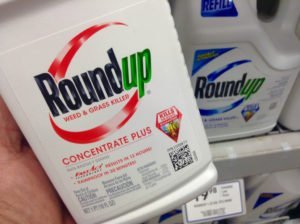Monsanto’s Roundup, a top-selling weed killer used in parks, school yards, and farms is being placed under scrutiny for its potentially hazardous ingredients.
The Russian Deputy Prime Minister, Arkady Dvorkovich, has joined forces with the California Environmental Protection Agency’s Office of Environmental Health Hazard Assessment, labeling some key ingredients as a carcinogen.
Which ingredients are carcinogenic?
The main carcinogen that has been identified is known as glyphosate, but the inert ingredients that form part of the weed-killing mixture have actually been shown to amplify its toxicity to human cells.
One of the inert ingredients, polyethoxylated tallow amine (POEA), has been proven to be even more deadly, killing human embryonic, placental, and umbilical cord cells. This can lead to abnormal fetal development, pregnancy problems, low birth weights, and miscarriages.
Inert ingredients are solvents, preservatives, surfactants, and other chemicals that manufacturers add to pesticides.
Study authors from the University of Caen in France say: “This clearly confirms that the inert ingredients in Roundup formulations are not inert. Moreover, the proprietary mixtures available on the market could cause cell damage and even death at the residual levels.”
What can glyphosate do?
Dr. Stephanie Seneff, a research scientist at MIT (Massachusetts Institute of Technology) has confirmed that glyphosate has been linked to the development of a range of chronic conditions and diseases, including cancer, infertility, Alzheimer’s disease, autism, multiple sclerosis, and gastrointestinal disorders.
Four different Roundup formulations were studied in France, which all contained glyphosate and POEA at lower concentrations that commonly used on lawns and farms. It was found that the ingredients in all four formulations caused damage to three types of cells, including embryonic, placental, and umbilical cord cells.
According to one of the researchers, these two ingredients work together to “limit the breathing of cells, which stresses them and drives them to suicide.”
Ecologists from the University of Pittsburgh tested Roundup on ponds in 2005, ensuring that they used the recommended dose. Within 14 days, 50-100% of several species of tadpoles in the pond were found dead, which proved the toxicity to living cells.
What does the manufacturer say? 
Monsanto’s Roundup manufacturer says that the study methods do not reflect realistic conditions, claiming that cells were subjected to abnormally high doses of their ingredients.
“It’s very unlike anything you’d see in real-world exposure. People’s cells are not bathed in these things,” said Donna Farmer, a toxicologist at Monsanto.
John Combest, the spokesman of Monsanto, said that they have one of the most extensive human health safety and environmental data packages of any pesticide on the market, which is why it’s being used in parks and schools.
The Environmental Protection Agency agrees that, at the recommended dose, Roundup has a low level of toxicity. They have also classified POEA as safe to the environment and public health.
However, the French team strongly disagrees, saying that the authorizations for using these herbicides must be revised since their toxic effects depend on, and are amplified, by other ingredients used in the mixture.
A group of more than 250 environmental, health, and labor organizations are petitioning against the EPA’s requirements to identify the inert ingredients present in pesticides. The agency will make a decision by the end of fall.
Sources:
https://www.osha.gov/SLTC/carcinogens/
https://integrativeoncology-essentials.com/2013/03/pesticides-herbicides-and-cancer/
https://www.ncbi.nlm.nih.gov/pmc/articles/PMC1061291/
https://www.ncbi.nlm.nih.gov/pubmed/17165105
https://www.scientificamerican.com/article/weed-whacking-herbicide-p/
https://monsantoblog.eu/monsanto-transitions-away-from-tallowamine-in-products-enfr/






